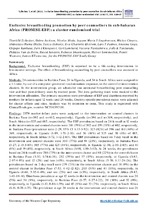Exclusive breastfeeding promotion by peer counsellors in sub-Saharan Africa (PROMISE-EBF): a cluster-randomised trial
Date
2011Author
Tylleskar, Thorkild
Jackson, Debra
Meda, Nicolas
Ingrebetsen, Ingunn Marie S
Chopra, Mickey
Diallo, Abdoulaye Hama
Doherty, Tanya
Ekström, Eva-Charlotte
Fadnes, Lars Thore
Goga, Ameena
Kankasa, Chipepo
Klungsøyr, Jørn I
Lombard, Carl
Nankabirwa, Victoria
Nankunda, Jolly K
Van de Perre, Philippe
Sanders, David
Shanmugam, Rebecca
Sommerfelt, Halvor
Wamani, Henry
Tumwine, James K
PROMISE-EBF Study Group
Metadata
Show full item recordAbstract
Background: Exclusive breastfeeding (EBF) is reported to be a life-saving intervention in low-income settings. The
effect of breastfeeding counselling by peer counsellors was assessed in Africa.
Methods:24 communities in Burkina Faso, 24 in Uganda, and 34 in South Africa were assigned in a 1:1 ratio, by use
of a computer-generated randomisation sequence, to the control or intervention clusters. In the intervention group,
we scheduled one antenatal breastfeeding peer counselling visit and four post-delivery visits by trained peers. The
data gathering team were masked to the intervention allocation. The primary outcomes were prevalance of EBF and
diarrhoea reported by mothers for infants aged 12 weeks and 24 weeks. Country-specific prevalence ratios were
adjusted for cluster effects and sites. Analysis was by intention to treat. This study is registered with ClinicalTrials.gov,
number NCT00397150.
Findings 2579 mother–infant pairs were assigned to the intervention or control clusters in Burkina Faso (n=392 and
n=402, respectively), Uganda (n=396 and n=369, respectively), and South Africa (n=535 and 485, respectively). The
EBF prevalences based on 24-h recall at 12 weeks in the intervention and control clusters were 310 (79%) of 392 and
139 (35%) of 402, respectively, in Burkina Faso (prevalence ratio 2·29, 95% CI 1·33–3·92); 323 (82%) of 396 and
161 (44%) of 369, respectively, in Uganda (1·89, 1·70–2·11); and 56 (10%) of 535 and 30 (6%) of 485, respectively, in
South Africa (1·72, 1·12–2·63). The EBF prevalences based on 7-day recall in the intervention and control clusters
were 300 (77%) and 94 (23%), respectively, in Burkina Faso (3·27, 2·13–5·03); 305 (77%) and 125 (34%), respectively,
in Uganda (2·30, 2·00–2·65); and 41 (8%) and 19 (4%), respectively, in South Africa (1·98, 1·30–3·02). At 24 weeks,
the prevalences based on 24-h recall were 286 (73%) in the intervention cluster and 88 (22%) in the control cluster
in Burkina Faso (3·33, 1·74–6·38); 232 (59%) and 57 (15%), respectively, in Uganda (3·83, 2·97–4·95); and 12 (2%)
and two (<1%), respectively, in South Africa (5·70, 1·33–24·26). The prevalences based on 7-day recall were
279 (71%) in the intervention cluster and 38 (9%) in the control cluster in Burkina Faso (7·53, 4·42–12·82);
203 (51%) and 41 (11%), respectively, in Uganda (4·66, 3·35–6·49); and ten (2%) and one (<1%), respectively, in
South Africa (9·83, 1·40–69·14). Diarrhoea prevalence at age 12 weeks in the intervention and control clusters
was 20 (5%) and 36 (9%), respectively, in Burkina Faso (0·57, 0·27–1·22); 39 (10%) and 32 (9%), respectively, in
Uganda (1·13, 0·81–1·59); and 45 (8%) and 33 (7%), respectively, in South Africa (1·16, 0·78–1·75). The prevalence
at age 24 weeks in the intervention and control clusters was 26 (7%) and 32 (8%), respectively, in Burkina Faso
(0·83, 0·45–1·54); 52 (13%) and 59 (16%), respectively, in Uganda (0·82, 0·58–1·15); and 54 (10%) and 33 (7%),
respectively, in South Africa (1·31, 0·89–1·93).
Interpretation: Low-intensity individual breastfeeding peer counselling is achievable and, although it does not affect
the diarrhoea prevalence, can be used to effectively increase EBF prevalence in many sub-Saharan African settings.

